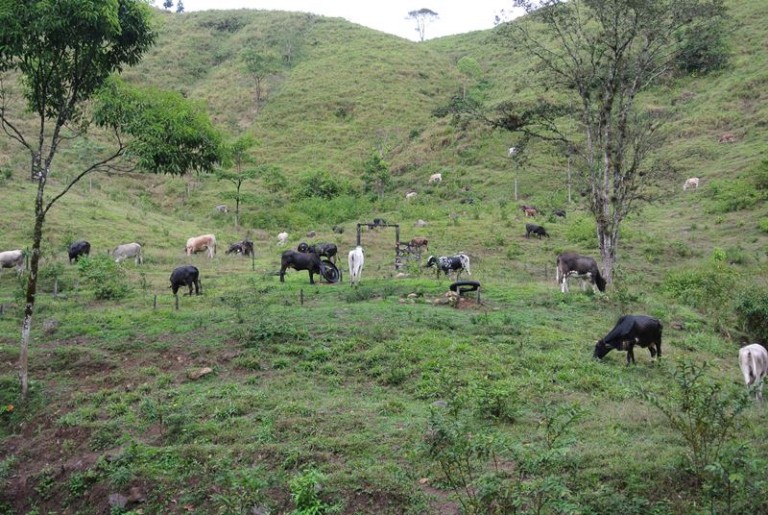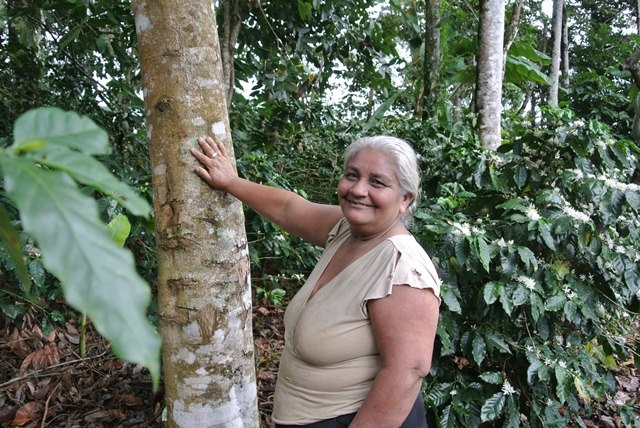The global land restoration movement launched in Bonn five years ago is gaining steam. It’s big and it’s ambitious. In Latin America and the Caribbean, where it is called Initiative 20X20, it aims to bring 20 million hectares of degraded land into restoration by 2020 – an area almost twice the size of Guatemala.
By raising capital and guiding restoration scientifically and programmatically, the partnership of governments, regional programs, private sector actors, researchers and NGOs, hopes to work with farmers and ministries to undertake the oftentimes painstaking work that restoration can involve. The World Agroforestry Centre (ICRAF) supports 20×20 with analysis, design and tools, including the Land Degradation Surveillance Framework.
Landscape restoration is the process of regaining ecological functionality. It usually involves increasing the diversity, number and health of trees.
“The importance of trees to restoration can be seen in landscapes without them,” says Jonathan Cornelius, who heads ICRAF in Latin America. “There life is blighted by wind and heat, riverbanks erode, pollinators struggle to find habitats, carbon sequestration is minimal, nutrient recycling is impeded, pest control and nutrient availability rely on fossil-fuel based inputs, and essential tree products are lacking or cripplingly expensive.”
With 40% of Latin America’s land area under annual or permanent crops or pastures, agroforestry is the path to the restoration of production landscapes that is emerging most strongly. Defined as the growing of woody perennials on the same unit of land as crops and/or livestock, agroforestry can take the shape of any of a myriad of systems, including cocoa or coffee under diverse shade trees or silvopastoralism, a form of agroforestry where cattle graze amid trees.
But “it is not planting trees for planting’s sake,” says ICRAF scientist Valentina Robiglio whose work focuses on the Peruvian Amazon. That could bring grave risks of rendering people landless with trees or planting the wrong ones in the wrong place — such as species with little market value, trees on old growth grassland or, say, the invasive Indian neem tree in humid forests.
Restoration is expected to create rural jobs, repair broken ecosystems, increase productivity, protect biodiversity, and more – although how investments will work still needs clarity. “My question is how a restoration investment can generate returns and an investment designed to deliver returns can also deliver restoration” says forester Katalin Solymosi from the Inter-American Development Bank, which backs 20×20. The answer lies partly in solutions such as agroforestry, which can deliver substantial financial and social returns on investments while also providing many of the environmental services that motivate restoration initiatives.

In contrast, the urgency to act is entirely clear. “Agriculture provides 50% of income in rural areas in Latin America,” says Walter Vergara, who coordinates Initiative 20×20 for the World Resources Institute (WRI). “But it is responsible for 50% of our greenhouse gas emissions and has degraded 200 million hectares.”
The historical degradation is just one worry, adds the Colombian forests and climate specialist. Rampant degradation is on-going. “We lose 3.4 million hectares of forest a year in Latin America,” he says.
In Nicaragua, which has pledged to restore 2.9 million hectares, forest is succumbing daily to expanding pasture. “It’s important to stop the red monster of the advance of the agricultural frontier,” says Paul Oquist, Minister-Private Secretary for National Policies for the Presidency of the Republic of Nicaragua.
The agricultural frontier is advancing apace in Peru too, where Jorge Torres, an official from the Ministry of the Environment, advocates granting land titles and promoting agroforestry to “stabilize” farmers where they are. “Already 10 million hectares are abandoned,” he says. “We need to title land and help farmers to be more productive with cattle, coffee, cocoa and oil palm in agroforestry systems.”
John Sánchez from Colombia’s Ministry for Sustainable Development describes restoration as a “complex integrated” process in which local people play a role and the aim is not necessarily to return land to its original state. He distinguishes it from rehabilitation, recuperation and reclamation. This is not hair-splitting; it is key. In Latin America, restoring land functions – such as the ability to support plant life and regulate the storage and flow of surface water and groundwater – can cost up to USD 5000 per hectare. It is crucial to get it right.
And getting it right means balancing trade-offs between ecological functions with social and economic goals, striking a balance between environmental services and rural livelihoods, notes Andrew Miccolis, who heads ICRAF in Brazil. “This is where agroforestry has a key role to play: it enables restoring degraded lands while also generating income, increasing food security and a host of other crucial social benefits.”
Besides agroforestry, restoration can also involve suppressing fire, removing invasive plants and enriching natural forests. The last is favoured by the UK investment fund Permian, headed by banker Stephen Rumsey, who sees it as “the only really viable technology to sequester carbon”.
“Readiness for investment” is scarce in poor rural areas, however. Kaspar Wansleben of the Forestry and Climate Change Fund in Luxembourg says, “Best case, it takes a year to prepare small farmers for investment. We focus on those with residual secondary forest. You have to aggregate farms – for example, through cooperatives— to get a viable size for administration, marketing and technical support.” Moringa Fund, with Euro 85 million and backed by the Rothschild family and forest agency of France among others, has been able to invest just once so far — in an almost utopian coffee estate in Nicaragua.
Impact investors associated with 20×20 are committing substantial funds, part of the almost USD 1 billion assembled to date. The Dutch development bank, European Investment Bank, Credit Suisse and Church of Sweden have invested in the Althelia Climate Fund. A typical Althelia project in Peru involves an NGO, a national park, private company and communities. Revenue is from carbon and Fairtrade organic no-deforestation cocoa or fairly traded beef. Euro 100 million will be fully invested by the end of 2016 and a second fund raised in June 2016 for investment later.
EcoEnterprises Fund has invested USD 100 million in agroforestry, wild harvested products, sustainable working landscapes, and biopreservation, says managing director Nathalie Prado. The Terra Bella Fund invests in recharge generation, fruit production, and “secure land change for the ‘bottom of the pyramid’ rural poor,” says Nicole Rossell, its co-head for Latin America.
Private investment is just part of the solution, however. “Our next phase is to work closely with governments”, says WRI’s Rene Zamorra. German Obando from the International Union for the Conservation of Nature agrees, saying, “What really works is a national development plan. The big player is government.”
Countries are stepping up. Guatemala’s restoration target is 1.2 million hectares, and according to Ebal Sales, Director of National Forests, the government is funding half. “Over the next 30 years,” he says, “1 percent of the national budget will go to smallholders to plant trees. We estimate that restoration will bring USD 43 million a year in co-benefits such as water and generation of electricity.”
Initiative 20X20 faces a tall order to turn around, but the building blocks are starting to be clear.
